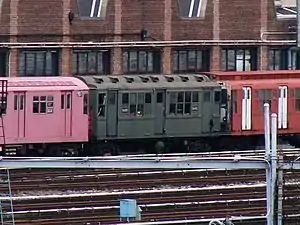World's Fair Lo-V (New York City Subway car)
The World's Fair Lo-V was a New York City Subway car type built in 1938 by the St. Louis Car Company in St Louis, Missouri.[1][2] These 50 cars were ordered for the IRT Flushing Line in preparation for the 1939 World's Fair. They were the fourth and last "Lo-V" type cars that were ordered (after the Flivver Lo-Vs, Steinway Lo-Vs, and Standard Lo-Vs), and the last cars ordered for the IRT before the city takeover in 1940.
| World's Fair Lo-V | |
|---|---|
 World's Fair Lo-V car 5655 at the 207th Street Yard. | |
| Manufacturer | St. Louis Car Company |
| Constructed | 1938 |
| Number built | 50 |
| Number preserved | 1 |
| Number scrapped | 49 |
| Fleet numbers | 5653–5702 |
| Capacity | 48 (seating), 154 (standing) |
| Operator(s) | Interborough Rapid Transit New York City Transit Authority |
| Specifications | |
| Car body construction | Steel |
| Car length | 51 ft 0 in (15.54 m) |
| Width | 8 ft 11.3125 in (2,726 mm) |
| Height | 11 ft 10.625 in (3,623 mm) |
| Doors | 6 |
| Weight | 75,130 lb (34,078 kilograms) |
| Traction system | Westinghouse UP231B with Westinghouse 336A1 traction motors (125 hp each). Two motors per motor truck. |
| Power output | 125 hp (93 kW) per traction motor |
| Electric system(s) | 600 V DC Third rail |
| Current collection method | Top running Contact shoe |
| Track gauge | 4 ft 8 1⁄2 in (1,435 mm) |
Description
The World's Fair Lo-Vs were numbered 5653–5702. These cars were all motor cars. They were modified variants of the standard IRT Steinway/Low-V body, with a body style based on the designs of the BMT Standards and IND Arnines. This included an ogee-styled roof, a door arrangement similar to those of BMT cars, rollsigns that marked the destination for each train, and a lack of vestibules. Additionally, these cars were single-ended units, with the operator's controls on one end, and the conductor's controls on the opposite end.[3]
While the cars cosmetically presented a more contemporary and more modern appearance, mechanically and electrically, they were Steinway cars and were compatible with the older Steinways, as they also contained the special gear ratios required to climb the steep grades (4.5%) of the Steinway Tunnels. However, as the World's Fair Lo-V was significantly different, it was a separate and distinct car class and not included in the "Steinway" grouping.
History
The World's Fair Lo-Vs began service on the Flushing Line, which was the line closest to the 1939 World's Fair. After the fair closed, they continued to operate on that line until 1950, when they were displaced by the new R12, R14, and R15 subway cars. Afterward, they were sent to the IRT Pelham Line, where they operated until 1956, when they were displaced by the new R17s. They were then assigned to the 7th Ave Bronx Express Line until 1962, when they were deemed surplus by the vast amount of new IRT subway cars being placed into service during this period. Finally, they were transferred to the IRT Third Avenue Line in the Bronx, where they spent their final years until they were replaced by the heavily modified R12s in late 1969. Many cars were converted into work motors with a 3 added in front of their original numbers, but were eventually replaced by retired SMEE cars converted into work cars in the 1990s, and were eventually scrapped.[4]
Car 5655 has been preserved by the New York Transit Museum and restored. It is currently in storage at the 207th Street Yard.[5]
See also
- Flivver Lo-V, a low voltage propulsion control IRT subway car built in 1915.
- Steinway Lo-V, a low voltage propulsion control IRT subway car built from 1915 to 1925.
- Standard Lo-V, a low voltage propulsion control IRT subway car built from 1916 to 1925.
References
- Cudahy, Brian J. (2003). A Century of Subways: Celebrating 100 Years of New York's Underground Railways. New York: Fordham University Press. ISBN 0-8232-2292-6.
- http://www.nycsubway.org/wiki/The_Interborough_Fleet,_1900-1939_(Composites,_Hi-V,_Low-V)
- https://www.nycsubway.org/wiki/The_Interborough_Fleet,_1900-1939_(Composites,_Hi-V,_Low-V)#Low-Voltage_.28Low-V.29
- https://www.nycsubway.org/wiki/Chapter_2,_The_IRT_Subway#Section_H:_The_Last_Cars_Built_For_the_Interborough
- http://www.nycsubway.org/perl/show?139302
External links
![]() Media related to World's Fair Lo-V (New York City Subway car) at Wikimedia Commons
Media related to World's Fair Lo-V (New York City Subway car) at Wikimedia Commons